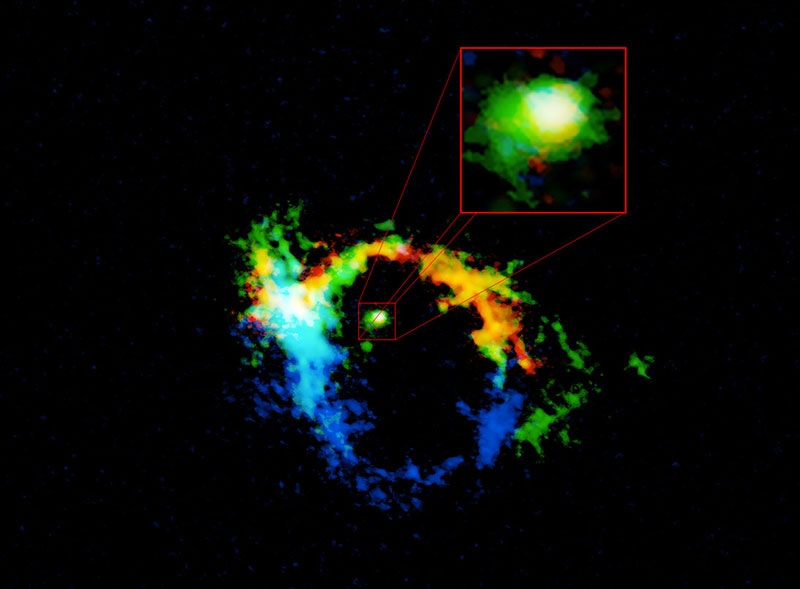Oct 7 2016
Ongoing research led by Bucknell University physics & astronomy professor Jack Gallimore is advancing science's understanding of the supermassive black holes found at the center of galaxies.
 The central region of galaxy NGC 1068, captured by ALMA. The torus of material harboring the supermassive black hole is highlighted in the pullout box. This region, which is approximately 40 light-years across, is the result of material flung out of the black hole's accretion disk. The colors represent the motion of the gas: blue is material moving toward us, red moving away. The areas in green are low velocity and consistent with rotation around a black hole. The white in the central region means the gas is moving both toward and away at very high speed. (Credit: Jack Gallimore; ALMA (ESO/NAOJ/NRAO); and B. Saxton (NRAO/AUI/NSF)
The central region of galaxy NGC 1068, captured by ALMA. The torus of material harboring the supermassive black hole is highlighted in the pullout box. This region, which is approximately 40 light-years across, is the result of material flung out of the black hole's accretion disk. The colors represent the motion of the gas: blue is material moving toward us, red moving away. The areas in green are low velocity and consistent with rotation around a black hole. The white in the central region means the gas is moving both toward and away at very high speed. (Credit: Jack Gallimore; ALMA (ESO/NAOJ/NRAO); and B. Saxton (NRAO/AUI/NSF)
In a paper published in September in the journal Astrophysical Journal Letters, Gallimore and an international team of researchers provided evidence for a shift in the geometric model of supermassive black holes and the clouds of gas and dust that surround them.
Making use of the Atacama Large Millimeter/submillimeter Array (ALMA), a recently completed radio observatory located in the remote Atacama Desert of Chile, Gallimore's team set its focus on NGC 1068, a barred spiral galaxy approximately 47 million light-years from Earth. At the galaxy's center is a supermassive black hole, millions of times more massive than black holes created in supernova explosions.
Supermassive black holes are surrounded by a thin, rotating disk of gas and dust known as an accretion disk. The view of this disk through optical telescopes is obscured by a thicker doughnut-shaped ring of dust and gas known as a torus.
"Think of a black hole as an engine. It's fueled by material falling in on it from a flattened disk of dust and gas," said Gallimore. "But like any engine, a black hole can also emit exhaust."
Understanding the geometry and relationship between these gaseous bodies and the black hole has proven problematic for astronomers, Gallimore explained. One problem with the traditional model of a black hole is that the "doughnut" surrounding the accretion disk is an inherently unstable shape. Another lies in the nature of the accretion disk itself.
"The Earth is not falling into the sun," Gallimore explained. "We keep falling towards it, but we have a sideways velocity that prevents us from ever falling in. The same is true for any orbit, and that includes gas that's orbiting a black hole."
In other words, Gallimore said, "once the gas is spinning it doesn't really want to fall into the black hole."
But to maintain nuclear activity, some of the material in the accretion disk must leak into the black hole, otherwise it would cool down and become invisible, Gallimore explained. To do so, the disk must shed some of its rotational velocity, or angular momentum. Data collected by Gallimore and his team using ALMA reveals that the black hole at the center of NGC 1068 reduces angular momentum by exhausting material from the edge of the accretion disk, creating its own torus.
ALMA is ideally suited to examine the makeup and motion of the molecular gas surrounding and obscuring supermassive black holes, and provided Gallimore's team — as well as two others concurrently studying the same galaxy — a clearer view of NGC 1068's core than has ever been witnessed before. Using the array of more than 50 radio telescopes, the researchers observed and measured the velocity of carbon monoxide clouds that lifted off the outer portion of the accretion disk at speeds of nearly 2 million miles per hour, fast enough to escape the gravitational field of the disk. He traveled to Chile in the summer to discuss his findings with observatory staff.
The team's findings provide evidence for a new model of the torus surrounding the accretion disk — it's not a doughnut but a cone, comprised of gas exiting, not entering, the black hole. The data suggests that the general theory of an active black hole is oversimplified, Gallimore concluded.
"These clouds are traveling so fast that they reach 'escape velocity' and are jettisoned in a cone-like spray from both sides of the disk," said Gallimore. "With ALMA, we can for the first time see that it is the gas that is thrown out that hides the black hole, not the gas falling in."
Gallimore's team also observed the outflow from the black hole in additional molecular lines, giving him added confidence in his observations. He plans to detail those findings in a future paper. He also intends to continue making observations of NGC 1068 using ALMA. With future observations, his team hopes to calculate the black hole's fuel budget: how much mass per year goes into the black hole and how much is ejected as exhaust.
"These are fundamental quantities for understanding black holes that we really don't have a good handle on at this time," Gallimore said.